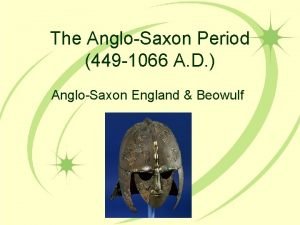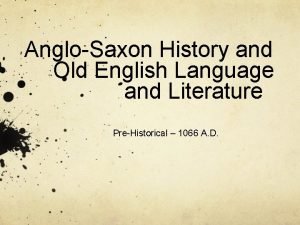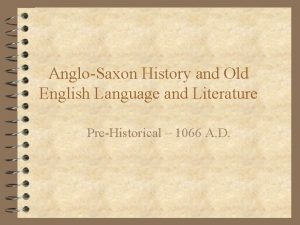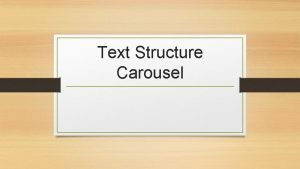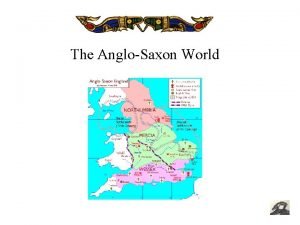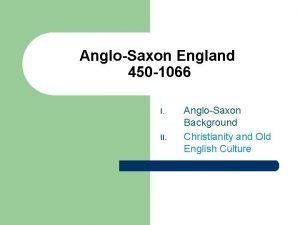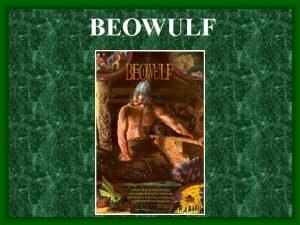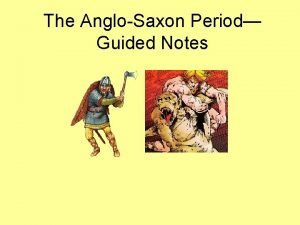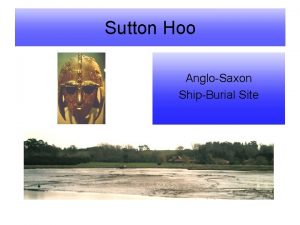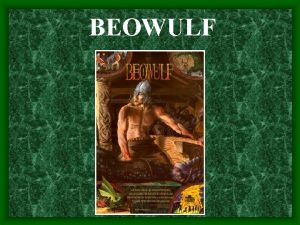AngloSaxon Poetry What to FORGET Forget that you














- Slides: 14

Anglo-Saxon Poetry

What to FORGET • Forget that you “read” poetry • Anglo-Saxon audiences listened to a bard (or • • • scop) recite or sing the poetry. Anglo-Saxon poetry was oral/aural. Forget that “nations” are rather large entities now. Anglo-Saxon world was tribal Different way of seeing where they lived; different “laws” and ways of life

The Basic Rules • Alliteration: central organizing poetic device in Anglo-Saxon poetry • The basic formal unit in A-S poetry is the single line, not a stanza or a couple of lines (couplets, quatrains, etc. ).

Alliteration • Alliteration is “The repetition of consonant sounds in words that are close to one another” (Elements 1259). • It is the use of words with similar sounding beginnings (Great, big gobs of greasy, grimy, gopher guts. . . ) • Alliteration linked the two halves of a line of poetry. The line was divided by a caesura, which is. . .

Caesura • . . . Caesura is “A pause or break within a line of • • • poetry, usually dictated by the natural rhythm of language” (Elements 1260). In Anglo-Saxon, the Caesura occurs in the middle of the line. Words in one half of the line were stressed one way, while words in the second half could be stressed another. The stresses, the alliteration, and the caesura are tied together in a rather complex way. . .

An Example: • The best way to understand Anglo-Saxon poetry is to see an example: Alliteration of /sc/ sounds; further alliteration in /b/ sound “Oft Scyld Scefing Stresses in first half sceaÞena Þreatum” Stresses in second half Caesura This is the fourth line of Beowulf.

Kennings • Simple definition: A kenning is a compound word • More precise definition (from Elements): – “The Kenning, a specialized metaphor made of compound words, is unique to the Old Germanic languages, and is especially prominent in Old Norse and Anglo-Saxon literature. – The earliest and simplest kennings are compound words formed of two common nouns: “sky-candle” for the sun, “battle-dew” for blood, and “whale-road” for the sea. – Later, kennings grew more elaborate, and compound adjectives joined the compound nouns. A ship became a “foamy-throated ship, ” then a “foamythroated sea-stallion, ” and finally a “foamy-throated stallion of the whale-road’” (40).

Why did poets use kennings? • “Scholars believe that kennings filled three needs for these early bards: ” (Elements 40) 1. Alliteration’s centrality to the poetry creates a need for words with certain sounds, so the bards created new words 2. Bards needed to memorize the poetry (remember, it was oral/aural), and kennings helped them remember parts of the poem 3. Audiences would have liked the “elaborate” coining of the phrases.

Tone • You will notice that the tone of Beowulf is somber, or dark. There a few reasons for this (my own reasoning): – The poet is reminiscing about “the good ol’ days” and the code of honor which is dying – The poem itself is about loss—loss of innocence, loss of life, loss of one’s lords, friends, etc. It is about loss through death. – The peoples in the poem lived in constant fear of the elements and their human predators

The Use of Digressions • The term “digression” has a rather negative • connotation, but as Seamus Heaney argues, when the Beowulf poet gets off topic (off of the central story-line), it appears almost always to be for a very good reason. Ultimately, the poem is very complex, and certainly not “rambling, ” or as we say today, “random. ” The digressions almost always shed light on the characters, their actions, and the Anglo-Saxon & Scandinavian worlds.

The Major Digressions • Apart from minor moves in and out of the central story line, there are two major digressions. Each is an example of a storywithin-a-story (in this case, a song within a song): 1. 883 -914: the story of Siegemund’s victory over a dragon 2. 1070 -1158: “The Finnsburg Episode” • There are other digressions, too: – Unferth’s challenge (Unferth tells one version of the story (brief and defamatory), and Beowulf tells another (honorable)

Other Minor Literary/Poetic Devices Used in Beowulf • Synecdoche: a part used for the whole – Keel used for ship – Iron used for sword • Variation: the use of parallel and appositive expressions • which gives the verse a highly structured and musical quality (Norton Introduction 6) Irony: achieved through indirection, sometimes understatement (litotes = a classical rhetorical term which means “ironic understatement”). Irony is not just used as a figure of speech, it is used as a mode of perception (Beowulf when young contrasted with older Hrothgar and even older version of Beowulf) (Norton Intro. 6)

Review of Important Terms • Alliteration (the most important term) • Caesura • Kenning • Tone • Digression • Story-within-a-story

Bibliography • Abrams, M. H. , and Stephen Greenblatt, Eds. • • • Introduction. The Norton Anthology of English Literature, seventh ed. , vol. 1. New York: W. W. Norton, 2000. 1 -22, 29 -32. Anderson, Robert, et al. Eds. Elements of Literature, Sixth Course, Literature of Britain. Austin: Holt, Rinehart and Winston, 1993. 2 -42. Burrow, J. A. “Old and Middle English Literature, c. 7001485. ” The Oxford Illustrated History of English Literature. Ed. Pat Rogers. Oxford: Oxford UP, 1987. Heaney, Seamus. Introduction. Beowulf. Trans. Seamus Heaney. New York: W. W. Norton & Co. , 2000. ix-xxx.
 Anglo saxons alphabet
Anglo saxons alphabet Anglosaxon history
Anglosaxon history Old english kingdoms
Old english kingdoms Phân độ lown ngoại tâm thu
Phân độ lown ngoại tâm thu Block xoang nhĩ
Block xoang nhĩ Thơ thất ngôn tứ tuyệt đường luật
Thơ thất ngôn tứ tuyệt đường luật Thơ thất ngôn tứ tuyệt đường luật
Thơ thất ngôn tứ tuyệt đường luật Chiến lược kinh doanh quốc tế của walmart
Chiến lược kinh doanh quốc tế của walmart Tìm vết của đường thẳng
Tìm vết của đường thẳng Con hãy đưa tay khi thấy người vấp ngã
Con hãy đưa tay khi thấy người vấp ngã Tôn thất thuyết là ai
Tôn thất thuyết là ai Gây tê cơ vuông thắt lưng
Gây tê cơ vuông thắt lưng Sau thất bại ở hồ điển triệt
Sau thất bại ở hồ điển triệt Elements of spoken word poetry
Elements of spoken word poetry What do finding nemo and robocop have in common
What do finding nemo and robocop have in common
